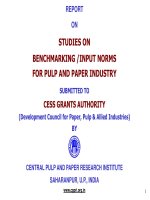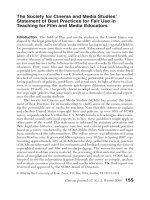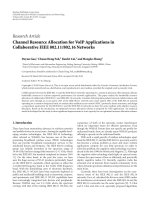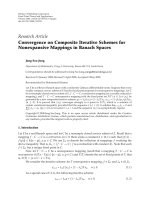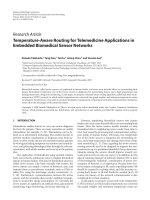Experimental computational studies on transition metal silicides for novel applications in advance CMOS technologies 2
Bạn đang xem bản rút gọn của tài liệu. Xem và tải ngay bản đầy đủ của tài liệu tại đây (147.38 KB, 13 trang )
i
Acknowledgements
It is my great pleasure to have the opportunity here to record my gratitude to
people and institutions that made this thesis possible.
Foremost, I would like to express my utmost gratitude and appreciation to my
supervisor, Professor FENG Yuan Ping for his invaluable guidance, kindness and
encouragement throughout my research. And it is my co-supervisor Dr. ZHENG Jia
Zhen who guides me into the field on CMOS and transition-metal silicides.
I would like to thank Dr. Lap CHAN and Dr. Alex SEE in Chartered
Semiconductor Manufacturing Ltd for their education on the advanced technologies in
semiconductor industry. I also thank Assoc. Prof. SHEN Ze Xiang, Assoc. Prof.
Thomas OSIPOWICZ, Dr. LIU Jin Ping, and Dr. CHI Dong Zhi for their constructive
suggestions and great support on my experimental work.
My gratitude is also conveyed to all my colleagues and friends in Theoretical
and Computational Condensed Matter Physics group, Laser Spectroscopy Laboratory
group, and Special Project group, for their continuous co-operations, fruitful
discussions, and warm care during my PhD study.
The award of Research Scholarship by National University of Singapore and
the financial support from Chartered Semiconductor Manufacturing Ltd. throughout
this project are highly appreciated.
Finally, I owe my beloved family for their consistent love and support.
ii
Table of Contents
Acknowledgements……………………………………………………………………i
Table of Contents……………………………………………….…………………ii
Summary……………………………………………………………………………v
List of Tables………………………………………………………………………viii
List of Figures………………………………………………………………………ix
Chapter 1 Introduction…………………………………………………………1
1.1 Evolution of CMOS Technologies……………………………………1
1.2 Transition-Metal Silicides……………………………………………7
1.3 Objective and Scope…………………………………………………17
References……………………………………………………………19
Chapter 2 Experimental and Computational Methodologies………………24
2.1 Thin Film Growth………………………………….…………………24
2.2 Thin Film Characterization Techniques……………………………29
2.3 First-Principles Calculation………….………………………………37
References……………………………………………………………52
Chapter 3 Growth and Stability of Ultra-Thin Nickel Silicide Films………55
3.1 Introduction…………………………………………………………55
3.2 Ultra-Thin Nickel Silicide Film Growth……………………………56
3.3 Electrical Property of Nickel Silicides………………………………57
iii
3.4 Phase Identification and Transformation……………………………60
3.5 Thermal Stability……………………………………………………65
3.6 Conclusions…………………………………………………………70
References………………………………………………………… 71
Chapter 4 Surface and Interface Roughness of Silicide Thin Films…………72
4.1 Introduction…………………………………………………………72
4.2 New Approach by Micro-Raman Imaging…………………………74
4.3 Modeling of Interface Roughness……………………………………77
4.4 Surface and Interface Roughness……………………………………81
4.5 Agglomeration Mechanism…………………………………………95
4.6 Conclusions…………………………………………………………99
References……………………………………………………………99
Chapter 5 Interface Reconstruction of Silicide/Si(001) Heterostructure…101
5.1 Introduction…………………………………………………………101
5.2 Interfacial Structures of Silicide/Si(001)……………………………102
5.3 Models and Calculation Details……….……………………………105
5.4 Results and Discussion…………………………….………………109
5.5 Conclusions…………………………………………………………117
References………………………………………………………… 118
Chapter 6 Strain Effects on Interface of Silicide/Si(001) Heterostructure 120
6.1 Introduction…………………………………………………………120
6.2 Total Energy Calculations…………………………………………122
iv
6.3 Strain Effect on Interface Atomistic Configuration………………127
6.4 Strain Effect on Interface Formation Energetics……………………129
6.5 Strain Effect on Electronic Properties………………………………131
6.6 Strain Effect on Schottky Barrier Height…………………………135
6.7 Conclusions…………………………………………………………146
References…………………………………………………………147
Chapter 7 Ge Composition Effects on Formation of Germanosilicides……149
7.1 Introduction…………………………………………………………149
7.2 Total Energy Calculations…………………………………………151
7.3 Ge Composition Effect on Atomistic Structure……………………160
7.4 Ge Composition Effect on Energetics………………………………161
7.5 Ge Composition Effect on Electronic Properties…………………164
7.6 Conclusions ………………………………………………………171
References…………………………………………………………171
Chapter 8 Conclusions and Future Work……………………………………173
8.1 Conclusions…………………………………………………………173
8.2 Future Work………………………………………………………175
Publication List……………………………………………………………………177
v
Summary
Transition-metal silicides are self-aligned to Si with low resistivity, good
adhesion, and self-passivation characters. Silicides have been widely used to decrease
contact resistance and thus increase speed of devices in complementary metal-oxide-
semiconductor (CMOS) ultra-large-scale integration (ULSI) technologies. Among
various silicides, titanium, cobalt, and nickel silicides are the most popular materials
used in Si fabrication process.
Rapid pace of development leads semiconductor industry exciting but facing a
lot of challenges. As device feature dimensions shrink to nanoscale, new
architectures and materials have to be employed. Silicides have been extensively
studied for a few decades both experimentally and theoretically. However, most of the
studies have been carried out on the conventional bulk Si substrate. Silicides for
advanced CMOS technologies are still not well-studied due to the lack of effective
characterization tools and their formation mechanisms are still far from deep
understanding. The goal of this research is to fill in some of the technical gaps
through both experimental and theoretical approaches.
Ultra-shallow junction is a necessity of shrinkage in lateral dimensions of
CMOS devices. To avoid excessive consumption of silicon, ultra-thin silicide films
must be adopted. The formation process and stability of ultra-thin nickel silicide
films with as-deposited metal thickness down to 4nm have been systematically
studied. It was found that thermal stability of NiSi degrades gradually with the
vi
decrease in the as-deposited Ni film thickness, especially when thinner than 8nm.
Both the NiSi film agglomeration and the NiSi
2
phase transformation take place at
lower temperatures as Ni film thickness decreases. Interface condition is crucial for
applications of ultra-thin films. To effectively determine the morphology of
interfaces between silicide thin films and silicon substrate, a new technique, micro-
Raman imaging (µMI), has been successfully developed in our study based on
modeling and experiments. The thickness of silicide films is determined by the
attenuation of Si Raman peak at 520cm
-1
. Compared with cross-section TEM and
SEM, micro-Raman imaging does not require special sample preparation and can
easily resolve features of micrometer scale in a plane and nanometer scale in the
normal direction.
Strained-Si is a promising replacement of conventional Si substrate due to the
enhanced carrier mobility of both electrons and holes. Various interface structures of
CoSi
2
/Si(001) and NiSi
2
/Si(001) system with different degrees of strain have been
intensively investigated. To understand the effects of strain/stress, first-principles
calculation was used to expand the system to extreme conditions (from fully-relaxed
to fully-strained) which is difficult to reach via experimental approaches. A new
model for the MSi
2
/Si interface, the sevenfold-Z model with a zigzag Si dimer
arrangement at the interface, has been proposed. The proposed model is equally
possible as the existing model with comparable interface formation energy and atomic
plane space. The possible coexistence of this model and the existing one can well
explain the ambiguity in the earlier STEM study. Strain does show great impact on
atomistic, energetic, electronic and transport properties of the interfaces. With
vii
biaxially tensile strain induced by Si substrate, the atomic distance in the
perpendicular axis is compressed accordingly. In terms of energetics, the higher the
in-plane strain, the smaller the interface formation energy generally. Strain in
substrate also causes the compression in PDOS of Si atoms, but has less impact on
metal atoms. Most importantly, Schottky barrier height of the MSi
2
/Si(001)
heterojunction changes significantly with strain, which has direct impact on device
performance.
As new materials are being introduced into advanced CMOS technologies,
such as SiGe, chemical composition of the substrates will also influence the solid-
state reaction process in silicidation. Germanosilicides Co(Si
1-x
Ge
x
)
2
and Ni(Si
1-
x
Ge
x
)
2
with different Ge compositions, ternary compounds formed on Si
1-x
Ge
x
substrates, have been systematically investigated using first-principle method.
Simulation results show that Ge composition dominates the configuration of the
ternary compounds. The equilibrium volume of M(Si
1-x
Ge
x
)
2
shows a linear increase
with the increase of the Ge composition x, following Vegard’s law. Si/Ge-rich
system tends to form the MSi
2
plus Ge rather than MSiGe and SiGe or MGe
2
and Si.
The lower cohesive energy of M(Si
1-x
Ge
x
)
2
with larger x explains the reason for the
tendency of Ge agglomeration and cluster formation in the compounds under thermal
stress. Ge composition also affects electronic properties of silicides. With increase of
the Ge composition, upward shift of the valance bands and compression of the whole
energy states are observed. The M d
−
band becomes stronger and narrower with the
increase of Ge composition in the silicides.
viii
List of Tables
Table 1.1 Important properties of common self-aligned silicides.
Table 3.1 Silicide film thickness and relative ratios of silicide to Ni films for
different as-deposited metal films.
Table 5.1 Optimized lattice parameter
c
(Å) and calculated interface formation
energy.
form
E∆ is the difference in formation energy of a given structure
and that of the sevenfold-R model.
Table 5.2 Bond length (Å) between interface metal atoms and their neighboring Si
atoms for sevenfold-R and Z configurations. Refer to Figure 5.6 for
labels of the bonds.
Table 5.3 Calculated inter-atomic-plane distance (Å) for the sevenfold-R and Z
models of NiSi
2
/Si(001). Refer to Figure 5.6 for labeling of atomic
planes.
Table 6.1 Calculated lattice constants of Si, CoSi
2
, and NiSi
2
with strain varying
from 0% (fully-relaxed as
Si
a ) to 100% (fully-strained as
Ge
a ).
Table 6.2 Equilibrium lattice constant
0
c and volume
0
V of various MSi
2
/Si(001)
interface structures with substrate strain varying from 0% to 100%.
Table 6.3 Minimum total energy and interface formation energy of various
MSi
2
/Si(001) interface structures with substrate strain varying from 0%
to 100%.
Table 6.4 Lineup and p-type SBH
p
Φ
of various MSi
2
/Si(001) interface structures
with substrate strain varying from 0% to 100%.
Table 7.1 Lattice constants of Co, Ni, Si, CoSi
2
and NiSi
2
obtained by LDA and
GGA.
Table 7.2 Calculated equilibrium volume, total energy, and bulk modulus of
M(Si
1-x
Ge
x
)
2
with Ge composition x variation.
ix
List of Figures
Figure 1.1 Cross section of modern CMOS transistor with an n-channel MOSFET
and a p-channel MOSFET.
Figure 1.2 Intel CPU processing power projection by Moore’s Law. (Cited from
Figure 1.3 Phase diagram of Ni-Si phase binary system. (Cited from SGTE alloy
databases 2004)
Figure 2.1 Schematic illustration of a RF sputtering chamber.
Figure 2.2 Schematic diagram of a rapid thermal processing system.
Figure 2.3 Energy level diagram of Raman scattering.
Figure 2.4 Schematic diagram of a four-point probe.
Figure 2.5 Principle of Rutherford Back-scattering Spectrometry.
Figure 2.6 Schematic diagram of an atomic force microscope (cited from Vecco
application notes).
Figure 3.1 Sheet resistance of nickel silicide (NiSi and NiSi
2
) films as a function of
initial Ni thickness and annealing temperature.
Figure 3.2 Silicide formation rate as a function of the initial Ni film thickness. To
calculate the film thickness, the resistivity of NiSi and NiSi
2
are taken as
13 ohm/sq and 50 ohm/sq respectively.
Figure 3.3 Raman spectra of NiSi formed at 450°C with different initial Ni
thickness.
Figure 3.4 Raman spectra of NiSi
2
formed at 800°C with different initial Ni
thickness.
Figure 3.5 Raman spectra of NiSi formed at 450°C and NiSi
2
formed at 800°C on
(100) Si substrates. The Raman spectrum with co-existence of two
phases indicates the phase transition process from NiSi to NiSi
2
at the
critical temperature of 750°C.
x
Figure 3.6 RBS spectra of 16nm as-deposited Ni films under various thermal
treatments, (a) uniform NiSi film formed at 500°C, (b) agglomerated
NiSi film formed at 750°C, and (c) NiSi
2
film formed at 850°C.
Figure 3.7 AFM images of Ni/Si samples with 16nm as-deposited Ni on top of Si
substrates annealed at (a) 500°C, (b) 600°C, (c) 700°C, (d) 750°C, (e)
800°C, and (f) 850°C. RMS surface roughness increases with
temperature dramatically when temperature higher than 750°C.
Figure 3.8 Comparison of sheet resistance and surface roughness of 16nm Ni/Si
samples as a function of annealing temperatures.
Figure 4.1 Schematic diagram of the scanning Raman system: 1-XYZ scanning
stage, 2-tip, 3-driving piezo, 4-laser diode, 5-microscope objective, 6-
laser, 7-Raman signal, 8-quadrant detector, 9-sample, 10-controllor, 11-
spectrometer, 12-computer. 1, 2, 3, 4 and 8 constitute the scanning head,
which is put on the mechanical stage of the microscope. Laser is
delivered by microscope objective 5, which is also used to collect
Raman signal in this embodiment.
Figure 4.2 Schematic diagram of film thickness measurement by micro-Raman
spectroscopy. The laser and Raman signal are exponentially attenuated
by the optical absorption thin film.
Figure 4.3 Schematic diagram of thin film with (a) two-step interface and (b)
sinusoidal interface configurations.
Figure 4.4 Calculation results of Si Raman peak intensity attenuation at 520cm
-1
as
a function of (a) uniformity variable x for two-step configuration; and (b)
amplitude A for sinusoidal configuration.
Figure 4.5 Si Raman peak intensity at 520cm
–1
attenuated by NiSi thin films. The
inset shows the calculated NiSi film thickness from 45nm down to 10nm,
which is verified by RBS, where the Si peak intensity of the film with
thickness of 10nm is chosen as the reference intensity I
0
.
Figure 4.6 Standard deviation of Si Raman peak intensity and derived film
thickness. The 30nm NiSi film forms under 500°C RTA.
Figure 4.7 Raman spectra of the C49 phase, C54 phase and C40 phase TiSi
2
on
(100) Si substrates. The C49 phase is annealed by RTA, while the C40
phase is annealed by PLA. The C54 phase can be obtained based on
both of them.
Figure 4.8 Micro-Raman images of (a) C49 TiSi
2
phase formed at 600°C and (b)
C54 TiSi
2
phase formed at 800°C plotted by intensity of Si Raman peak.
xi
Figure 4.9 Micro-Raman image of as-deposited 16nm pure Ni film plotted by (a)
the intensity of Si Raman peak at 520cm
-1
and (b) the resulting
calculated thickness of the film.
Figure 4.10 Cross-section SEM image of the interface between NiSi film and Si
substrate.
Figure 4.11 Micro-Raman images of NiSi film formed in N
2
ambient at 500°C for
30s, plotted by (a) the intensity of Si Raman peak at 520cm
-1
and (b) the
resulting calculated thickness of the film.
Figure 4.12 Micro-Raman images of NiSi film formed in N
2
ambient at 500°C for
30s, plotted by (a) the intensity of Si Raman peak at 520cm
-1
and (b) the
intensity of NiSi Raman peak at 214cm
-1
.
Figure 4.13 AFM and Micro-Raman morphologies of NiSi films after annealing at (a)
500°C, (b) 600°C, (c) 700°C, and (d) 750°C.
Figure 5.1 Conventional MSi
2
/Si(001) interface models: (a) sixfold, (b) eightfold,
(c) LJY, (d) BJV, (e) sevenfold unconstructed, and (f) sevenfold
reconstructed.
Figure 5.2 Interface structures, (a) sixfold; (b) eightfold; (c) sevenfold-R; and (d)
sevenfold-Z, of MSi
2
/Si interface in
110
<
>
(top) and
110<>
(bottom)
directions. Si atoms are shown by the yellow balls while metal atoms
are represented by the blue balls.
Figure 5.3 (a) Side view and (b) top view of the sevenfold-R and sevenfold-Z
interface structures. For easy reference, metal atoms at the layer beneath
are projected to the interfacial layer. Si atoms are shown by the yellow
balls while metal atoms are represented by the blue balls.
Figure 5.4 Calculated total energy as a function of the lattice parameter
c
, for the
four interface models with 13 atomic layers of CoSi
2
and 15 atomic
layers of Si each.
Figure 5.5 Calculated total energy as a function of the lattice parameter c , for the
four interface models with 13 atomic layers of NiSi
2
and 15 atomic
layers of Si each.
Figure 5.6 Bond and atom layer of sevenfold-Z interface structures in (a)
110<>
and (b)
110<>
directions. Si atoms are shown by the yellow/light balls
while metal atoms are represented by the blue/dark balls.
Figure 5.7 Contour plots of valence electron charge density (electron/A
3
) at the Si-
dimer interface plane for (a) sevenfold-R model and (b) sevenfold-Z
model, overlaid by atomic structures at the interface plane with Si atoms
(light sphere) and projected M atoms (dark ball) for easy reference.
xii
Figure 6.1 Stacking structure of a thin strained-Si layer grown on relaxed Si
1-x
Ge
x
.
Figure 6.2 Total energy per supercell versus c axis length of various CoSi
2
/Si(001)
interface supercells on free (solid symbol) and 20% strained (open
symbol) Si substrate as example.
Figure 6.3 Total energy per supercell of CoSi
2
/Si(001) and NiSi
2
/Si(001) interface
supercells as a function of Si substrate strain.
Figure 6.4
0
c and
0
V of CoSi
2
/Si(001) sixfold and sevenfold-R interface supercell
as a function of Si substrate strain.
Figure 6.5 Interface formation energy of CoSi
2
/Si(001) and NiSi
2
/Si(001) interface
supercells as a function of Si substrate strain.
Figure 6.6 Projected density of states of Si at atomic layers from Si bulk to
interface to CoSi
2
bulk in CoSi
2
/Si(001) sixfold interface supercell with
free Si substrate. Fermi energy of the system is 5.797 eV.
Figure 6.7 Projected density of states of Si at atomic layers from Si bulk to
interface to NiSi
2
bulk in NiSi
2
/Si(001) sixfold interface supercell with
free Si substrate. Fermi energy of the system is 5.886 eV.
Figure 6.8 PDOS of Si atoms at interfacial layer in CoSi
2
/Si(001).
Figure 6.9 PDOS of Co atoms at interfacial layer in CoSi
2
/Si(001).
Figure 6.10 Schematic band diagrams for metal/Si heterojunction. Definition of
Schottky barrier heights (
n
Φ
and
p
Φ
) is shown.
Figure 6.11 Planar and macroscopic average of electrostatic potentials of various
CoSi
2
/Si(001) interfaces structures with free Si substrate.
Figure 6.12 Planar and macroscopic average of electrostatic potentials of various
NiSi
2
/Si(001) interfaces structures with free Si substrate.
Figure 6.13 Macroscopic average of electrostatic potentials of various CoSi
2
/Si(001)
interfaces structures.
Figure 6.14 Macroscopic average of electrostatic potentials of various NiSi
2
/Si(001)
interfaces structures.
Figure 6.15 p-type SBH of CoSi
2
/Si(001) and NiSi
2
/Si(001) interface supercells as a
function of Si substrate strain. .
Figure 7.1 Crystal structure of (a) face-centred cubic Co/Ni, (b) diamond Si, and (c)
cubic MSi
2
.
xiii
Figure 7.2 Crystal structure of cubic M(Si
0.5
Ge
0.5
)
2
(Grey – Metal, White – Si,
Black – Ge).
Figure 7.3 Possible configurations of Si atoms substituting by Ge atoms for
M(Si
0.5
Ge
0.5
)
2
(White – Si, Black – Ge).
Figure 7.4 Total energy per unit cell versus volume change of Co(Si
1-x
Ge
x
)
2
as a
function of Ge composition x.
Figure 7.5 Total energy per unit cell versus volume change of Ni(Si
1-x
Ge
x
)
2
as a
function of Ge composition x.
Figure 7.6 Unit cell volume of M(Si
1-x
Ge
x
)
2
change with Ge composition x.
Figure 7.7 Cohesive energy E
coh
of M(Si
1-x
Ge
x
)
2
change with Ge composition x.
Both of them have a negative bowing parameter.
Figure 7.8 Band structure and DOS of MSi
2
. Fermi level is set at the origin.
Figure 7.9 Band structures of MSi
2
(solid line), MSiGe (dash line), and MGe
2
(dot
line). Fermi level is set at the origin.
Figure 7.10 M(Si
1-x
Ge
x
)
2
DOS shifts with Ge composition x. Fermi level is set at the
origin.
Figure 7.11 M(Si
1-x
Ge
x
)
2
projected DOS shifts with Ge composition x. Fermi level
is set at the origin.


